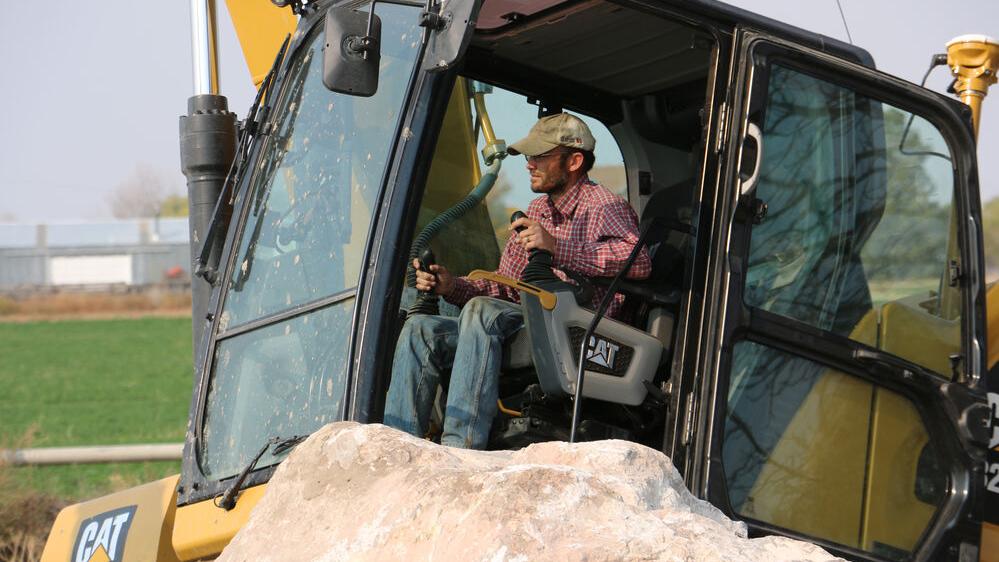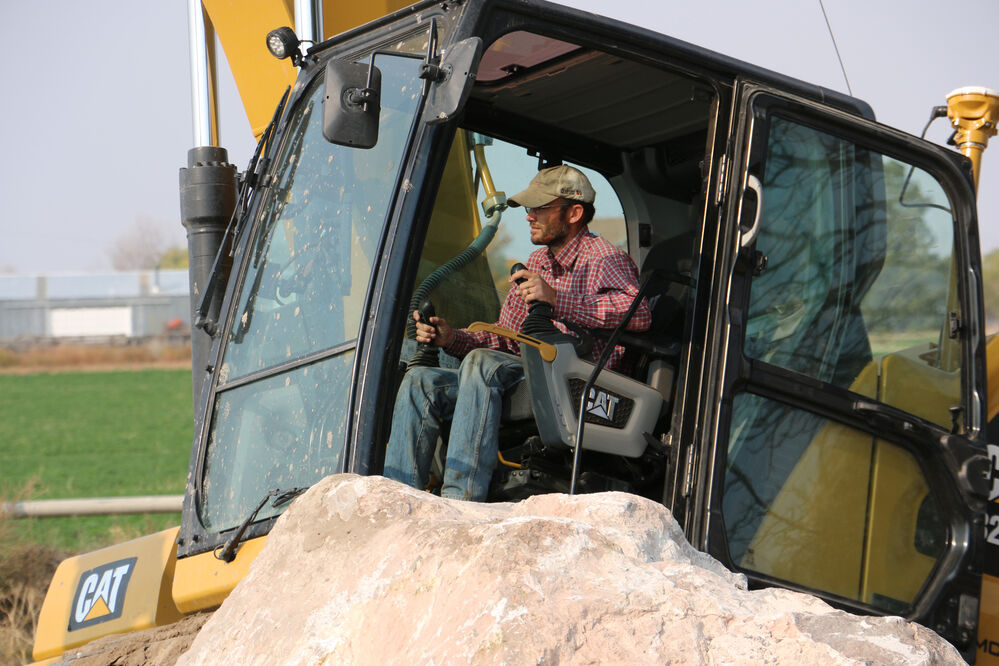

Matt Loomis of Whiskey Board Construction works to move a boulder that will be used as part of a habitat structure in Dry Spotted Tail Creek.
MITCHELL — The fishing and wildlife habitat around Dry Spotted Tail Creek has been in need of improvement for some time.
Over the course of several years of conversations and plan submissions, there is now work being done to improve the creek and adjoining land along County Road E northwest of Mitchell. The project will realign the creek as it approaches the North Platte River to make it more of a fishery, add a number of rock habitat structures to improve fish habitat and create a new wetland to serve as water fowl habitat.
Ducks Unlimited, Nebraska Game and Parks Wildlife and Aquatics Divisions, Pheasants Unlimited, Nebraska Environmental Trust, Nebraska Trout Unlimited and Platte River Basin Environments (PRBE) all came together for the project. U.S. Fish and Wildlife and representatives from the Iowa Conservation Corps have participated in the work as well.
PRBE is now into 30 years in conservation in the valley, according to Hod Kosman. What started as a diversion project for the creek was expanded to include the wetland area.
“The diversity of things we can work on is really exciting,” he said. “This just shows how you start off with a project, and we find a way to expand and enhance that project. ... It shows how you can take a lot of dedicated people and some partners and really good science and, if you are to find the money like we were able to through Trout Unlimited and the Environmental Trust Fund, you can make great things happen for this region.”
A project of this size is rare, especially in this area.
“This is a little unusual,” Matt Steffl, from Nebraska Game and Parks Wildlife Division said, “especially with the tying of stream components with upland components and everything else around it. This is a rather unique one, and a great opportunity for us.”
Mark Porath, Aquatic Habitat Program manager for Nebraska Game and Parks, applauded the project and the thought that has gone into it.
“It’s really a great example of where natural resource management has to go,” he said. “Public-private partnership are what is really needed to make a big difference in making holistic changes to our landscape. It’s a great coming together of a bunch of entities that were all interested, and we could come together and marshal all of our forces, if you will, and put together a really neat project. Quite honestly, no one could have done it without the others.”
Bob Smith, property manager for PRBE, said he is happy with how things are progressing.
“We had our doubts a little bit when we first started, but now I think those are gone,” Smith said. “I think eventually this is going to be a show place. Once it heals up, it’s going to be beautiful.”
Both Russ Smith from Smith Excavation and Matt Loomis of Whiskey Board Construction said they are proud to have been apart of the work, calling it both fun and challenging.
Bruce Rolls from PRBE said the project is expected to help bring back water fowl and also reestablish a migrating strain of rainbow trout that was in the creek from the 1940s until the late 1970s.
“If we can get some of that migrating strain reestablished, in Dry Spotted Tail, it will take care of itself eventually,” Rolls said.
David Bidelspach, with Five Smooth Stones Restoration working with Barr Engineering for the design of the river structures, said the structures will provide fish with a place where they can sit and wait for bugs or smaller fish to come by, a La-Z-Boy of sorts for fish. He said the wetlands area will help in a number of ways.
“You don’t see Dry Spotted Tail Creek get up over the bank very often and flood over a flood plain, so you don’t have the function that’s created by wetting and drying of a flood plain,” he said. “When we did the reconfiguration down there, we created low banks that will allow for flood plain reconnection, and we will see a lot more frequent flooding. With that, you see cottonwood generation, you see willows that will volunteer in that area, so you’re going to see more of a riparian corridor that’s created there.”
Tom Peterson, a Ducks Unlimited biologist, said the idea to move the water came up several years ago, then it was a matter of finding a way to do it and raise the funds for the project.
“The idea is only as good as your ability to leverage that to raise money,” Peterson said. “It took a few years, but we were finally able to get the right people and have some success. ... Wildlife money, wetland money, fisheries money, it really took lots of partners.”
Kosman said it came down to science to get the project underway.
“You can envision this project, but then you need some engineering and some biology to come out and say, ‘No, this will work,’” he said. “Once you have the science people saying this will work, then the money is easier to come by, and that’s the way it should be. You shouldn’t be doing projects that are silly.”
Steffl said his department has been working with Ducks Unlimited to create an improved habitat based on the new water table.
“The vegetation component should be stronger for a variety of upland game,” Steffl said. “All around, it’s going to be a much better area for both fishing and hunting opportunity as well as all our non-game species.”
Now that dirt is moving, Kosman said there is one big challenge remaining — their own imagination.
“I think that’s a great point, Hod,” Peterson said. “As we’ve gotten further into this, we just keep coming up with more ideas. We’re talking about additional fishing areas. The rocks that are in the stream are something that wasn’t in the original plan. The wetlands have come on later on. Everything is coming together, just picturing more and more ideas to put in to this thing.”
PHOTOS: Dry Spotted Creek

Excavators work in tandem to place a boulder as part of a structure to provide improved fish habitat in Dry Spotted Tail Creek.
PHOTOS: Dry Spotted Creek

Drake Yates of Whiskey Board Construction positions a boulder for placement in Dry Spotted Tail Creek as part of a project to improve fish habitat.
PHOTOS: Dry Spotted Creek

Drake Yates of Whiskey Board Construction takes some measurements in Dry Spotted Tail Creek as boulders are placed to provide fish habitat.
PHOTOS: Dry Spotted Creek

Matt Loomis of Whiskey Board Construction works to move a boulder that will be used as part of a habitat structure in Dry Spotted Tail Creek.
PHOTOS: Dry Spotted Creek

Excavators work in tandem to place a boulder as part of a structure to provide improved fish habitat in Dry Spotted Tail Creek.
PHOTOS: Dry Spotted Creek

An island is part of a wetlands project that will go along with the reconfiguration of Dry Spotted Tail Creek.
PHOTOS: Dry Spotted Creek

Drake Yates of Whiskey Board Construction tries to get a libe of sight as he positions a boulder for placement in Dry Spotted Tail Creek as part of a project to improve fish habitat.
PHOTOS: Dry Spotted Creek

Matt Loomis of Whiskey Board Construction moves an 8-ton boulder that will be used as part of a habitat structure in Dry Spotted Tail Creek.
PHOTOS: Dry Spotted Creek

Drake Yates of Whiskey Board Construction uses an excavator to position a boulder in Spotted Tail Creek.
PHOTOS: Dry Spotted Creek

Matt Loomis of Whiskey Board Construction brings in a bucket load of boulders that will be used to create fish habitat in Dry Spotted Tail Creek. The boulders were brought in from Guernsey, Wyoming.
PHOTOS: Dry Spotted Creek

Bruce Rolls from Platte River Basin Environments talks with Matt Loomis of Whiskey Board Construction about a project to improve fishing habitat in Dry Spotted Tail Creek.
HIDE VERTICAL GALLERY ASSET TITLES
Subscribe to our Daily Headlines newsletter.
October 17, 2020 at 11:30AM
https://ift.tt/2T7hsEH
Agencies combine efforts to improve fish habitat at Dry Spotted Tail Creek - Scottsbluff Star Herald
https://ift.tt/35JkYuc
Fish
No comments:
Post a Comment